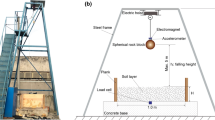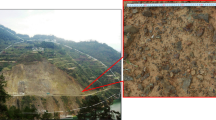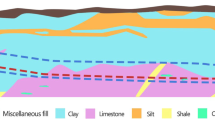Abstract
This study is devoted to understanding the impact of irregularly shaped rock blocks against a soil buffering layer above a rock shed via numerical simulations by discrete element method (DEM). In the DEM model, the rock block is represented by an assembly of densely packed and bonded spherical particles with the block shape reconstructed from the laser scanning results of a real rock block. The soil buffering layer is modeled as a loose packing of cohesionless frictional spherical particles, while the rock shed is simplified as a layer of fixed particles. The DEM model is first validated by modeling the impact of a cubic block against a soil buffering layer. Then, it is employed to investigate the dynamic interaction between a realistic-shaped rock block and the soil buffering layer. The numerical results show that the geometry of the contact surface between the rock block and soil layer can play a significant influence on the impact force of the rock block and the force acting on the rock shed. For the tested conditions, the distribution of stress on the rock shed can be well described by the Gaussian function, which seems to be independent on the geometry of the contact surface. In addition, the simplification of realistic-shaped rock blocks as spheres in the traditional DEM modeling approaches can significantly underestimate of the impact force. The established modeling strategy serves as a starting point for investigating the rock block shape. The proposed results can contribute to the choice of buffering layer for designing the rock shed.




















Similar content being viewed by others
References
Asahina D, Taylor MA (2011) Geometry of irregular particles: direct surface measurements by 3-D laser scanner. Powder Technol 213(1):70–78
Bourrier F, Nicot F, Darve F (2010) Evolution of the micromechanical properties of impacted granular materials. CR Mec 338:639–647
Breugnot A, Lambert S, Villard P, Gotteland P (2016) A Discrete/continuous coupled approach for modeling impacts on cellular geostructures. Rock Mech Rock Eng 49(5):1831–1848
Calvetti F (2008) Discrete modelling of granular materials and geotechnical problems. Eur J Envron Civ Eng 12:951–965
Calvetti F, di Prisco C (2012) Rockfall impacts on sheltering tunnels: Real-scale experiments. Géotechnique 62(10):865–876
Calvetti F, di Prisco C, Vecchiotti M (2005) Experimental and numerical study of rockfall impacts on granular soils. Riv Ital Geotec 4:95–109
Crosta GB, Agliardi F (2004) Parametric evaluation of 3D dispersion of rockfall trajectories. Nat Hazards Earth Syst Sci 4(4):583–598
Cundall PA, Strack ODL (1979) A discrete numerical model for granular assemblies. Géotechnique 29(1):47–65
Degago S, Ebeltoft R, Nordal S (2008) Effect of rock fall geometries impacting soil cushion: a numerical procedure. In: The 12th international conference of international association for computer methods and advances in geomechanics, India.
Delaunay B (1934) Sur la sphère vide. A la mémoire de Georges Voronoï. Bull l'Acad des Sci de l'URSS 6:793–800
di Prisco C, Vecchiotti M (2006) A rheological model for the description of boulder impacts on granular strata. Géotechnique 56(7):469–482
Dorren LKA (2003) A review of rockfall mechanics and modelling approaches. Prog Phys Geogr 27(1):69–87
Du H-b, Dai F, Xu Y, Yan Z, Wei M-d (2020) Mechanical responses and failure mechanism of hydrostatically pressurized rocks under combined compression-shear impacting. Int J Mech Sci 165:105219
Effeindzourou A, Giacomini A, Thoeni K, Sloan SW (2017) Numerical investigation of rockfall impacts on muckpiles for underground portals. Rock Mech Rock Eng 50(6):1569–1583
Fityus SG, Giacomini A, Buzzi O (2013) The significance of geology for the morphology of potentially unstable rocks. Eng Geol 162:43–52
Gao G, Meguid M (2018a) Modeling the impact of a falling rock cluster on rigid structures. Int J Geomech 18(2):1–15
Gao G, Meguid MA (2018b) Effect of particle shape on the response of geogrid-reinforced systems: insights from 3D discrete element analysis. Geotext Geomembr 46(6):685–698
Gao G, Meguid MA (2018c) On the role of sphericity of falling rock clusters—insights from experimental and numerical investigations. Landslides 15(2):219–232
Glover J, Bartelt P, Christen M, Gerber W (2015) Rockfall-simulation with irregular rock blocks. In: Lollino G (ed) Engineering geology for society and territory, vol 2. Springer International Publishing, Cham, pp 1729–1733
Guo N, Zhao J (2016) 3D multiscale modeling of strain localization in granular media. Comput Geotech 80:360–372
Guzzetti F, Reichenbach P (2010) Rockfalls and their hazard. In: Stoffel M, Bollschweiler M, Butler DR, Luckman BH (eds) Tree rings and natural hazards: a state-of-art. Springer, Dordrecht, pp 129–137
Japan Road Association (2000) Manual for Anti-impact Structures Against Falling Rocks, Japan.
Kang W, Feng Y, Liu C, Blumenfeld R (2018) Archimedes’ law explains penetration of solids into granular media. Nat Commun 9(1):1101
Katsuragi H, Durian DJ (2007) Unified force law for granular impact cratering. Nat Phys 3(6):420–423
Katsuragi H, Durian DJ (2013) Drag force scaling for penetration into granular media. Phys Rev E 87(5):052208
Labiouse V, Descoeudres F, Montani S (1996) Experimental study of rock sheds impacted by rock blocks. Struct Eng Int 3(3):171–176
Lambert S, Bourrier F (2013) Design of rockfall protection embankments: A review. Eng Geol 154:77–88
Lambert S, Gotteland P, Nicot F (2009) Experimental study of the impact response of geocells as components of rockfall protection embankments. Nat Hazards Earth Syst Sci 9(2):459–467
Liu Y, Dai F, Dong L, Xu N, Feng P (2018) Experimental investigation on the fatigue mechanical properties of intermittently jointed rock models under cyclic uniaxial compression with different loading parameters. Rock Mech Rock Eng 51(1):47–68
Liu Y, Dai F, Zhao T, Xu N-w (2017) Numerical investigation of the dynamic properties of intermittent jointed rock models subjected to cyclic uniaxial compression. Rock Mech Rock Eng 50(1):89–112
Ministry of Transport of the People's Republic of China (1995) Specifications for Design of Highway Subgrades (JTJ013–95).
Office fédéral des routes OFROU (2008) Actions de chutes de pierres sur les galeries de protection (ASTRA 12006), Bern
Paixão A, Resende R, Fortunato E (2018) Photogrammetry for digital reconstruction of railway ballast particles—a cost-efficient method. Constr Build Mater 191:963–976
Pichler B, Hellmich C, Mang HA (2005) Impact of rocks onto gravel design and evaluation of experiments. Int J Impact Eng 31(5):559–578
Potyondy DO, Cundall PA (2004) A bonded-particle model for rock. Int J Rock Mech Min Sci 41(8):1329–1364
Roethlin C, Calvetti F, Yamaguchi S, Vogel T (2013) Numerical simulation of rockfall impact on a rigid reinforced concrete slab with a cushion layer. Fourth International Workshop on Performance Protection and Strengthening of Structures, India
Shao Q (2017) ESyS-Particle gengeo-1.4. World Wide Web Address: https://launchpad.net/esys-particle/+milestone/gengeo-1.4. Accessed 6 Jan 2017
Shen W, Zhao T, Dai F, Jiang M, Zhou GGD (2019) DEM analyses of rock block shape effect on the response of rockfall impact against a soil buffering layer. Eng Geol 249:60–70
Shen W, Zhao T, Zhao J, Dai F, Zhou GGD (2018) Quantifying the impact of dry debris flow against a rigid barrier by DEM analyses. Eng Geol 241:86–96
Shen WG, Zhao T, Crosta GB, Dai F (2017) Analysis of impact-induced rock fragmentation using a discrete element approach. Int J Rock Mech Min Sci 98:33–38
Shi C, Li D-j, Xu W-y, Wang R (2015) Discrete element cluster modeling of complex mesoscopic particles for use with the particle flow code method. Granul Matter 17(3):377–387
Su Y, Cui Y, Ng CWW, Choi CE, Kwan JSH (2018) Effects of particle size and cushioning thickness on the performance of rock-filled gabions used in protection against boulder impact. Can Geotech J 56(2):198–207
Volkwein A, Schellenberg K, Labiouse V, Agliardi F, Berger F, Bourrier F, Dorren L, Gerber W, Jaboyedoff M (2011) Rockfall characterisation and structural protection—a review. Nat Hazards Earth Syst Sci 11(9):2617–2651
Wang Y (2009) A new algorithm to model the dynamics of 3-D bonded rigid bodies with rotations. Acta Geotech 4(2):117–127
Wang Y, Mora P (2009) The ESyS_particle: a new 3-D discrete element model with single particle rotation. Advances in geocomputing. Springer, Berlin Heidelberg, pp 183–228
Weatherley D, Hancock W, Boris V (2014) ESyS-particle tutorial and user's guide version 2.1. earth systems science computational centre, The University of Queensland.
Wei D, Wang J, Nie J, Zhou B (2018) Generation of realistic sand particles with fractal nature using an improved spherical harmonic analysis. Comput Geotech 104:1–12
Wei H, Zan L, Li Y, Wang Z, Saxén H, Yu Y (2017) Numerical and experimental studies of corn particle properties on the forming of pile. Powder Technol 321:533–543
Xu Y, Dai F, Xu NW, Zhao T (2015) Numerical investigation of dynamic rock fracture toughness determination using a semi-circular bend specimen in split hopkinson pressure bar testing. Rock Mech Rock Eng 49(3):731–745
Yan P, Zhang J, Fang Q, Zhang Y (2018) Numerical simulation of the effects of falling rock’s shape and impact pose on impact force and response of RC slabs. Constr Build Mater 160:497–504
Zhang L, Lambert S, Nicot F (2017a) Discrete dynamic modelling of the mechanical behaviour of a granular soil. Int J Impact Eng 103:76–89
Zhang L, Nguyen NGH, Lambert S, Nicot F, Prunier F, Djeran-Maigre I (2017b) The role of force chains in granular materials: from statics to dynamics. Eur J Environ Civ En 21(7–8):874–895
Zhang Y, Liu Z, Shi C, Shao J (2018) Three-dimensional reconstruction of block shape irregularity and its effects on block impacts using an energy-based approach. Rock Mech Rock Eng 51(4):1173–1191
Zhao T, Dai F, Xu N (2017) Coupled DEM-CFD investigation on the formation of landslide dams in narrow rivers. Landslides 14(1):189–201
Zhao T, Dai F, Xu NW, Liu Y, Xu Y (2015) A composite particle model for non-spherical particles in DEM simulations. Granul Matter 17(6):763–774
Zhou Y, Wang H, Zhou B, Li J (2018) DEM-aided direct shear testing of granular sands incorporating realistic particle shape. Granul Matter 20(3):55
Acknowledgements
This research was supported by the National Natural Science Foundation of China (grant 51779164, 41602289, and 41877260), the open funding of the State Key Laboratory of Hydraulics and Mountain River Engineering (Sichuan University) (No. Skhl1808), and the @RockHoriZon advanced tools for rockfall hazard and risk zonation at the regional scale (Grant 2016-0756), Fondazione CARIPLO.
Author information
Authors and Affiliations
Corresponding author
Additional information
Publisher's Note
Springer Nature remains neutral with regard to jurisdictional claims in published maps and institutional affiliations.
Rights and permissions
About this article
Cite this article
Shen, W., Zhao, T., Dai, F. et al. Discrete Element Analyses of a Realistic-shaped Rock Block Impacting Against a Soil Buffering Layer. Rock Mech Rock Eng 53, 3807–3822 (2020). https://doi.org/10.1007/s00603-020-02116-0
Received:
Accepted:
Published:
Issue Date:
DOI: https://doi.org/10.1007/s00603-020-02116-0




